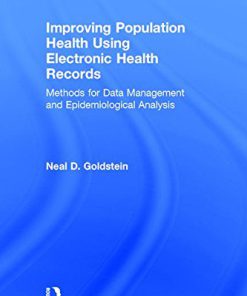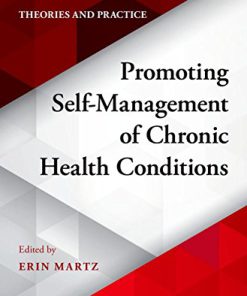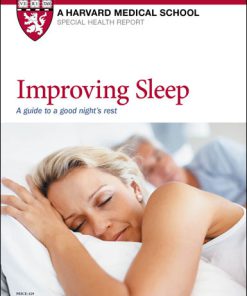Nursing Health Education and Improving Patient Self Management 1st Edition by Barbara Sassen 3319517698 9783319517698
$50.00 Original price was: $50.00.$25.00Current price is: $25.00.
Nursing: Health Education and Improving Patient Self-Management 1st Edition by Barbara Sassen – Ebook PDF Instant Download/DeliveryISBN: 3319517698, 9783319517698
Full download Nursing: Health Education and Improving Patient Self-Management 1st Edition after payment.

Product details:
ISBN-10 : 3319517698
ISBN-13 : 9783319517698
Author: Barbara Sassen
This book describes the latest advances in health education and patients’ self-management, addressing core questions such as: How can you motivate a patient to adopt a healthier lifestyle, and how can you support their self-management? Though there is a broad consensus within the nursing profession on the importance of health promotion and the promotion of self-management, nursing professionals often struggle with the underlying theoretical and practical aspects involved, as well as the right type of intervention to use and how to evaluate the results. The book departs from international trends, which primarily underline the importance of prevention and focus on such issues as the increase in the number of people with chronic health problems and co-morbidity, the empowerment of patients, and the technological developments in the health care system. In the first chapters, it examines health at the micro-, meso- and macro-level, combined with epidemiological health indicators. The following chapters focus on prevention, health promotion and self-management, while also broadly discussing prevention. The book then turns to the development and purpose of, as well as plans for, health promotion and health education. The Intervention Mapping protocol is the starting point, addressing questions such as how to motivate a patient to other, healthier behavior. Subsequently, the field of health promotion is extended to disease prevention, patient education and self-management. On the basis of patients’ needs, the book describes methods and interventions to promote self-management in detail. Self-management and chronic health problems are also highlighted, along with the patient’s social network in connection with self-management and eHealth. Lastly, the book explores the relationship between nursing and health promotion, as well as disease prevention, nursing diagnoses, nursing interventions and care results. Additionally, this edition includes two trainings on ‘Promoting the self-management of the patient ‘ and on ‘What is the role of the nursing professional in promoting self-management of the patient?’. This book is intended for bachelor and master courses for nursing professionals and is linked to the CanMeds competencies of health promoters and reflective evidence-based working professionals.
Nursing: Health Education and Improving Patient Self-Management 1st table of contents:
1: Health, Health Indicators, and Public Health
1.1 What Is Health? Using the ICF
1.2 International Classification of Functioning, Disability, and Health
1.3 Epidemiology and Epidemiological Research
1.4 Health Indicators, Mortality, Morbidity, and Multimorbidity
1.4.1 Mortality
1.4.2 Life Expectancy
1.4.3 Perceived Health
1.4.4 Years of Life Lost
1.4.5 Morbidity
1.4.6 Medical Consumption
1.4.7 Multimorbidity
1.4.8 Health Inequalities
References
2: Health, Health Risks, and Mapping Public Health
2.1 Lalonde Report
2.2 Endogenous, Personal Health Determinant
2.2.1 Endogenous Health Determinant: Genetic, Hereditary Factors
2.2.2 Endogenous, Personal Health Determinant: Acquired Properties
2.3 Health Determinants Lifestyle and Behavior
2.4 External Environment: Health Determinant Physical Environment
2.5 External Environment: Health Determinant Social Environment
2.6 Exogenous Health Determinant: Medical Care and Prevention
References
3: Prevention Within the Nursing Profession
3.1 Universal, Primary Prevention
3.2 Selective, Indicated, Secondary Prevention
3.2.1 Screening
3.2.2 Patients’ Delay and Doctors’ Delay
3.2.3 Case-Finding
3.3 Care-Related, Tertiary Prevention
3.4 Classifications of Prevention
3.5 Levels of Prevention, Individual, and Collective Prevention
3.6 Prevention and the Complexity of Health Behavior
3.7 Prevention: Health Protection, Health Promotion, and Disease Prevention
3.8 Health Protection
3.9 Health Promotion and Health Education: In Short
3.10 Health Education
3.11 Disease Prevention, Patient Education, and Self-Management: In Short
3.12 Patient Education
3.13 Self-management
3.14 Prevention: Targets
3.15 The Intertwining of Prevention and Care
References
4: Health Promotion and Health Education: Improving Patients’ Health Status
4.1 Health Promotion and Health Education: What Is the Difference?
4.2 Intentional Health Education and Facilitating Health Education
4.3 Intervention Mapping: Planning Model Intentional Health Education
4.4 Conditions and Principles of Intervention Mapping
4.5 Intervention Mapping Step 1: Needs Assessment
4.6 Intervention Mapping Step 1: Analysis of Lifestyle and Behavior
4.6.1 Explaining (Health) Behavior
4.6.2 Theory of Planned Behavior: Behavior and Intention
4.6.3 Theory of Planned Behavior: Barriers
4.6.4 Theory of Planned Behavior: Attitudes
4.6.5 Theory of Planned Behavior: Subjective Norms or Social Influence
4.6.6 Theory of Planned Behavior: Perceived Behavioral Control and Self-Efficacy
4.7 Intervention Mapping Step 2: Defining Performance and Change Objectives
4.7.1 Objectives
4.7.2 Performance Objectives
4.7.3 Change Objectives
4.8 Intervention Mapping Step 3: Methods and Theories for Change Intention and Behavior
4.8.1 Usefull Methods for Changing (Health) Behavior, Risk-Perception
4.8.2 Usefull Methods for Changing (Health) Behavior, Decisional Balance
4.8.3 Usefull Methods for Changing (Health) Behavior, Handling Social Influence
4.8.4 Usefull Methods for Changing (Health) Behavior, Guided Practice
4.8.5 Usefull Methods for Changing (Health) Behavior, Action Planning
4.8.6 Useful Methods for Changing (Health) Behavior, Coping Planning
4.9 Intervention Mapping Step 4: Designing the Health Intervention
4.10 Intervention Mapping Step 4: Model of Behavior Change
4.10.1 Model of Behavior Change: Contact the Patient, Risk Perception
4.10.2 Model of Behavior Change: Changing the Social–Cognitive Determinant Attitudes
4.10.3 Model of Behavior Change: Changing the Social–Cognitive Determinants Subjective Norms an
4.10.4 Model of Behavior Change: Changing the Social–Cognitive Determinants Perceived Behaviora
4.10.5 Model of Behavior Change: Achieving Changes in (Health) Behavior
4.10.6 Model of Behavior Change: Sustaining Changes in (Health) Behavior
4.11 Intervention Mapping Step 4: Designing the Health-Intervention – Stages of Change
4.12 Intervention Mapping Step 5: Implementation Plan
4.13 Intervention Mapping Step 6: Evaluation Plan
References
5: Patient Education and Improving Patients’ Self-Management
5.1 Disease Prevention, Patient Education, and Self-Management
5.2 Self-Management
5.3 Chronic Care Model
5.4 Stepped Care
5.5 Self-Management: Prerequisites
5.6 Barriers in Promoting Patients’ Self-Management: Provision of Information
5.7 Barriers in Promoting Patients’ Self-Management: Communication Between the Patient and the
5.8 Effects of Promoting Self-Management: Patient Satisfaction
5.9 Effects of Promoting Self-Management: Concordance
5.9.1 Nonconcordance: Characteristics
5.10 Effects of Promoting Self-Management: Understanding and Remembering
5.11 Effects of Promoting Self-Management: Patients’ Well-Being
5.12 Effects of Promoting Self-Management: Patient Participation
5.13 Effects of Promoting Self-Management: Shared Decision-Making
5.14 Effects of Promoting Self-Management: Improved Self-Management
5.15 Intervention Mapping for the Development of Self-Management Interventions
5.15.1 Intervention Mapping, Step 1: Assessing the Health Problem
5.15.2 Intervention Mapping, Step 2: Performance and Change Objectives to Improve Self-Management
5.15.3 Intervention Mapping, Step 3: Methods and Theories to Improve Self-Management
5.15.4 Intervention Mapping, Step 3: Methods and the Patient’s Phase of Life
5.15.5 Intervention Mapping, Step 4: Design of Self-Management Intervention
5.16 Intervention Mapping, Step 4: Model Supporting Patients’ Self-Management
5.16.1 Model Supporting Patient Self-Management: Intake and Risk Perception
5.16.2 Model Supporting Patient Self-Management: Attitudinal Change
5.16.3 Model Supporting Patient Self-Management: Resisting Social Pressure and Seeking Social Supp
5.16.4 Model Supporting Patient Self-Management: Perceived Behavioral Control and Self-Efficacy
5.16.5 Model Supporting Patient Self-Management: Planning Behavior Change
5.16.6 Model Supporting Patient Self-Management: Behavior Change and Handling Barriers
5.16.7 Model Supporting Patient Self-Management: Sustaining Behavior Change
5.17 Intervention Mapping, Step 4: Motivational Interviewing
5.18 Intervention Mapping, Step 4: Transtheoretical Model, Stages of Change
5.19 Intervention Mapping, Step 4: Patient Participation Model Improving the Self-Management in P
5.20 Intervention Mapping, Step 4: 5As
5.21 Intervention Mapping, Step 4: Ask-Tell-Ask
5.22 Intervention Mapping, Step 4: Supportive Social Relations
5.23 Intervention Mapping, Step 4: Informed Consent
5.24 Intervention Mapping, Step 4: eHealth
5.25 Intervention Mapping, Step 5: Implementation Plan Self-Management Intervention
5.25.1 Communication Process: Source
5.25.2 Communication Process: Message
5.25.3 Communication Process: Message—Patients’ Recalling and Participation
5.25.4 Communication Process: Strategy—Individual or Group Education
5.25.5 Communication Process: Strategy—Leaflets and Brochures
5.25.6 Communication Process: Receiver
5.26 Intervention Mapping, Step 5: Implementation Plan—Facilitation of the Self-Management Inte
5.27 Intervention Mapping, Step 6: Evaluation Plan
5.28 Training: Model Supporting Patient Self-Management
5.28.1 Training 1: Step Supporting Patient Self-Management—Intake and Risk Perception
5.28.2 Training 2: Step Supporting Patient Self-Management—Attitudinal Change
5.28.3 Training 3: Step Supporting Patient Self-Management—Resisting Social Pressure and Seeking
5.28.4 Training 4: Step Supporting Patient Self-Management—Perceived Behavioral Control and Self
5.28.5 Training 5: Step Supporting Patient Self-Management—Planning Behavior Change Using Action
5.28.6 Training 6: Step Supporting Patient Self-Management—Behavior Change and Handling Barriers
5.28.7 Training 7: Step Supporting Patient Self-�Management—Sustaining Behavior Change
References
6: The Nursing Professional as a Health Coach
6.1 Nursing Process, and Health Promotion and Disease Prevention
6.1.1 Nursing Assessment, and Health Promotion and Disease Prevention
6.1.2 Nursing Diagnosis, and Health Promotion and Disease Prevention
6.1.3 Nursing Planning Phase, and Health Promotion and Disease Prevention
6.1.4 Nursing Implementation Phase, and Health Promotion and Disease Prevention
6.1.5 Nursing Evaluation Phase and Health Promotion and Disease Prevention
6.2 Nursing Diagnoses Aimed at Promoting Patients’ Self-Management
6.3 Health Patterns Aimed at Promoting Patients’ Self-Management
6.4 Nursing Interventions Aimed at Promoting Patients’ Self-Management
6.5 Nursing Classification Systems, and Health and Patient Education
6.6 Nursing Interventions Aimed at Promoting Patients’ Self-Management, Using Intervention Mappin
6.7 Implementing Nursing Interventions Aimed at Promoting Patients’ Self-Management
6.7.1 Nursing Professional as a Health Coach: Introduction
6.7.2 Nursing Professional as a Health Coach: Risk Perception with Regard to Patients’ Self-M
6.7.3 Nursing Professional as a Health Coach: Changing Attitudes with Regard to Patients’ Sel
6.7.4 Nursing Professional as a Health Coach: Resisting Social Pressure and Seeking Support with
6.7.5 Nursing Professional as a Health Coach: Perceived Behavior Control and Self-Efficacy in R
6.7.6 Nursing Professional as a Health Coach: Planning Behavior Change with Regard to Patients
6.7.7 Nursing Professional as a Health Coach: Changing Behavior with Regard to Patients’ Self
6.7.8 Nursing Professional as a Health Coach: Sustaining Behavior Change with Regard to Improvi
6.8 Nursing Outcomes for Patient Self-Management
6.9 Training Nursing Professional as a Health Coach: with Regard to Improving Patients’ Self-
6.9.1 Training 1a: Health Coach—Introduction—Are You a Health Coach?
6.9.2 Training 1b: Health Coach—Risk Perception with Regard to Patient Self-Management
6.9.3 Training 2: Health Coach—Attitudinal Change with Regard to Patients’ Self-Management
6.9.4 Training 3: Health Coach—Resisting Social Pressure and Seeking Support with Regard to Pa
6.9.5 Training 4: Health Coach—Perceived Behavior Control and Self-Efficacy with Regard to Pat
6.9.6 Training 5: Health Coach—Planning Behavior Change with Regard to Patients’ Self-Managem
6.9.7 Training 6: Health Coach—Changing Behavior with Regard to Patients’ Self-Management, Us
6.9.8 Training 7: Health Coach—Sustaining Behavior Change with Regard to Improving Patients’
People also search for Nursing: Health Education and Improving Patient Self-Management 1st:
why health education is important in nursing
example of health education in nursing
nursing patient education strategies
why is patient education important in nursing
nursing education improves patient outcomes
Tags: Nursing, Health Education, Improving Patient, Self Management, Barbara Sassen
You may also like…
Medicine
Nursing Delegation and Management of Patient Care Kathleen Motacki 0323321151 9780323321150
Business & Economics
Medicine
Fragility Fracture Nursing: Holistic Care and Management of the Orthogeriatric Patient Karen Hertz
Relationships & Lifestyle - Alternative Medicine & Natural Healing
Improving Sleep 1st Edition by Harvard Health Publishing ISBN 1614012059 978-1614012054
Medicine
Telehealth Nursing Tools and Strategies for Optimal Patient Care 1st Edition Dawna Martich Msn Rn












